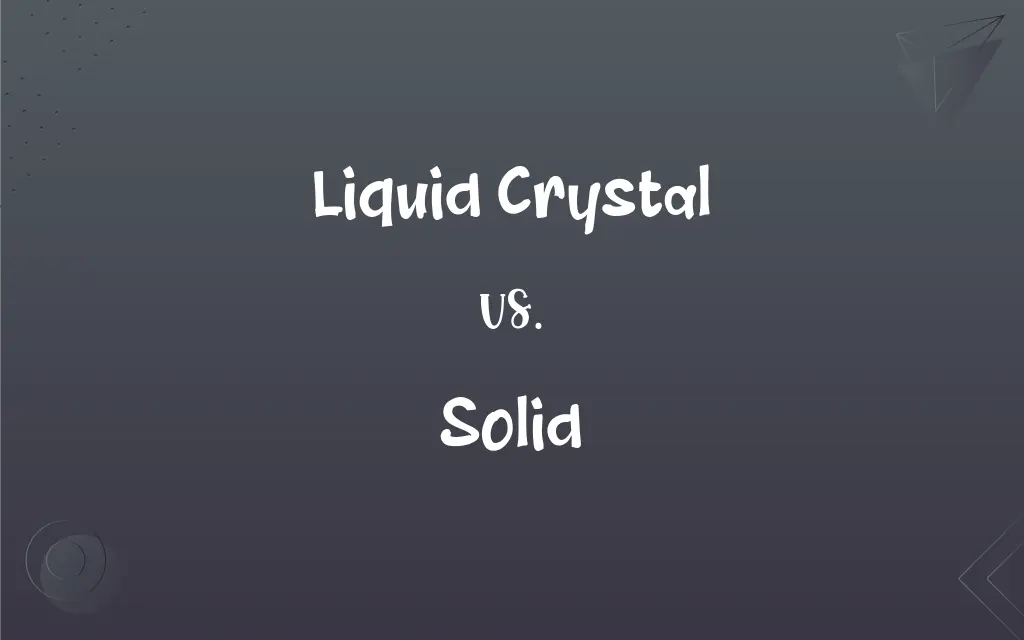Liquid Crystal vs. Solid: What's the Difference?
Edited by Aimie Carlson || By Janet White || Published on February 26, 2024
Liquid crystals are substances that exhibit properties between liquids and solids, while solids are materials with fixed shape and volume due to strong intermolecular forces.

Key Differences
Liquid crystals possess a unique state of matter, with molecular organization between a liquid and a solid. Solids have a well-defined, rigid molecular structure with strong intermolecular bonds.
Liquid crystals can flow like a liquid but maintain some order like a solid. Solids, in contrast, retain a fixed shape and volume, resisting flow under normal conditions.
Liquid crystals change their optical properties in response to external stimuli, making them useful in displays. Solids have consistent optical properties, not typically changing with external influences.
Liquid crystals have distinct phase transitions, changing states at specific temperatures. Solids remain in the same state unless subjected to extreme temperatures that cause melting or sublimation.
Liquid crystals are widely used in electronic displays and sensors. Solids find applications in a vast range of industries, from construction to manufacturing.
ADVERTISEMENT
Comparison Chart
Molecular Organization
Intermediate order between liquid and solid
Well-defined, rigid structure
Flow and Shape
Can flow, maintains some order
Fixed shape and volume, resists flow
Optical Properties
Change with external stimuli
Consistent, not typically changing
Thermal Behavior
Distinct phase transitions
Stable state until extreme temperatures
Applications
Used in displays, sensors
Used in construction, manufacturing
ADVERTISEMENT
Liquid Crystal and Solid Definitions
Liquid Crystal
Liquid crystals are substances that flow like a liquid but have some crystalline properties.
The display of a digital watch utilizes liquid crystal technology.
Solid
They are characterized by their rigidity and resistance to compression.
Diamonds, one of the hardest solids, are used in cutting tools.
Liquid Crystal
Liquid crystals are used in display technologies due to their unique optical properties.
Most modern TVs use liquid crystal displays for sharper images.
Solid
Solids can be crystalline, with an ordered structure, or amorphous, without long-range order.
Glass is an amorphous solid, lacking a regular crystalline structure.
Liquid Crystal
They align in different ways under electric fields, affecting their optical transmission.
The smartphone screen's liquid crystal alters its alignment when touched.
Solid
They maintain their shape due to the fixed position of their molecules.
Ice, a solid form of water, retains its shape unless melted.
Liquid Crystal
They exhibit phase transitions with changing temperatures or electric fields.
The liquid crystal in the thermometer changed color to indicate temperature.
Solid
Solids have a definite melting point at which they become liquid.
The melting of solid gold occurs precisely at 1,064°C.
Liquid Crystal
Liquid crystals are neither completely solid nor completely liquid.
The liquid crystal material retained some order despite being in a fluid state.
Solid
Solids are materials with a fixed shape and volume, having strong intermolecular forces.
The granite countertop, being a solid, is durable and stable.
Solid
Of definite shape and volume; not liquid or gaseous
It was so cold the water in the bucket became solid.
FAQs
How do liquid crystals work?
Liquid crystals flow like a liquid but have molecules oriented in a crystal-like way. They change phase in response to temperature or electrical currents, altering their optical properties.
Where are liquid crystals used?
They are commonly used in displays (LCDs), temperature sensors, and other electronic devices.
Can liquid crystals exist at room temperature?
Yes, some liquid crystal compounds can exist in their liquid crystalline phase at room temperature.
How are liquid crystals made?
They are typically synthesized from organic compounds, often involving a series of chemical reactions.
What is the structure of liquid crystals?
Their structure is a unique arrangement where molecules are more ordered than in a liquid but less so than in a solid crystal.
Are liquid crystals natural or synthetic?
They can be both; some are naturally occurring, while others are synthetically produced.
What is a crystalline solid?
A crystalline solid has a highly ordered arrangement of atoms, ions, or molecules.
What is a liquid crystal?
A liquid crystal is a state of matter that has properties between those of conventional liquids and solid crystals.
What are the types of liquid crystals?
The main types are nematic, smectic, and cholesteric, each with different molecular arrangements.
What defines a solid?
A solid is a state of matter characterized by structural rigidity and resistance to changes in shape or volume.
How are solids formed?
Solids form through processes like freezing, crystallization, or deposition.
How do liquid crystals affect light?
They can change the polarization of light, making them useful in display technologies.
What is an amorphous solid?
An amorphous solid lacks a long-range order in its atomic structure, resembling a liquid.
How do solids respond to temperature?
Solids expand when heated and contract when cooled, but remain in the same phase until melting.
What causes liquid crystals to change phase?
Changes in temperature, electric fields, or mechanical stress can cause phase changes.
What are the properties of solids?
Solids have definite shape and volume, high density, and low compressibility.
What is the difference between a solid and a liquid crystal?
A solid has a rigid structure, while a liquid crystal retains some fluidity and has a less ordered structure than a solid crystal.
How are solids classified?
They are classified based on their crystal structure: amorphous or crystalline.
Can solids flow?
Generally, solids don't flow under normal conditions but may deform under extreme pressure or temperature.
What are examples of solids?
Common examples include metals, ice, rocks, and plastics.
About Author
Written by
Janet WhiteJanet White has been an esteemed writer and blogger for Difference Wiki. Holding a Master's degree in Science and Medical Journalism from the prestigious Boston University, she has consistently demonstrated her expertise and passion for her field. When she's not immersed in her work, Janet relishes her time exercising, delving into a good book, and cherishing moments with friends and family.
Edited by
Aimie CarlsonAimie Carlson, holding a master's degree in English literature, is a fervent English language enthusiast. She lends her writing talents to Difference Wiki, a prominent website that specializes in comparisons, offering readers insightful analyses that both captivate and inform.







































































